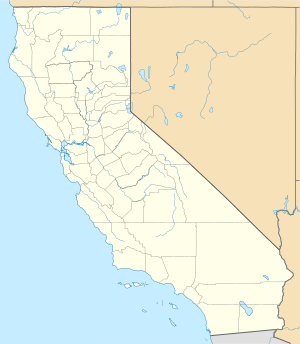Rockwell Field facts for kids
Quick facts for kids Rockwell Field |
|
|---|---|
| North Island, San Diego | |

Rockwell Field, California in 1924, looking north. Rockwell Field is in the foreground. On the other side of the island is the Naval Air Station San Diego.
|
|
| Coordinates | 32°41′51″N 117°11′51″W / 32.69750°N 117.19750°W |
| Type | Pilot training airfield (1912–1921) Rockwell Air Depot (1922–1939) |
| Site information | |
| Controlled by | United States Army Air Service United States Army Air Corps |
| Condition | Incorporated into Naval Air Station, North Island (1939) |
| Site history | |
| Built | 1911 |
| In use | 1912–1939 |
| Battles/wars | World War I |
|
Rockwell Field
|
|
| NRHP reference No. | 75002185 |
|---|---|
Rockwell Field was an important military airfield in the United States. It was located on North Island, near Coronado, California, across the bay from San Diego. This airfield played a huge role in developing American military aviation before and during World War I.
It began as a flying school run by Glenn Curtiss. In 1912, the U.S. Army set up a permanent flying school there. Rockwell Field became a major training center for pilots during World War I. It continued to be an Army Air Corps facility after the war. In 1939, the land was given to the United States Navy. Today, Rockwell Field is part of the Naval Air Station, North Island (NAS North Island). It was added to the National Register of Historic Places in 1991 because of its historical importance.
Contents
The Early Days of Rockwell Field
Rockwell Field was first known as the Signal Corps Aviation School. It was the very first U.S. Army school to teach military pilots how to fly. North Island was chosen as the school's first permanent home in 1912.
In 1910, Glenn H. Curtiss, a famous aviation pioneer, was drawn to North Island. The area had great weather, flat land, good beaches, and calm water. He decided to open a flying school there. At that time, North Island was a true island, separated from the mainland.
In January 1911, Curtiss signed a deal to use the land for three years. His flying school opened in February 1911. Curtiss invited both the Army and Navy to send officers to learn how to fly. The Army sent three airmen in early 1911, but they had to leave before finishing their training. The Navy also sent three pilots to Curtiss's school in 1911-1912.
The Army's Signal Corps Aviation School moved its planes to North Island in late 1912. They had been in Maryland before. Army flyers set up a camp in tents on the north end of the island. For about a year, the school rented planes and hangars from Curtiss. None of the very first buildings from this time still exist today. The historic buildings you can see now were built later, mostly between 1918 and 1935.
Rockwell Field During World War I
On July 20, 1917, the Signal Corps Aviation School was officially named Rockwell Field. This was to honor 2nd Lt. Lewis C. Rockwell. He had died in a plane crash in 1912. The United States had entered World War I earlier that year. There was a big need for trained military pilots.
In July 1917, the U.S. Congress allowed the President to take over North Island. This was for both Army and Navy aviation schools. President Woodrow Wilson signed an order in August 1917 to buy the land, which was still privately owned. The Army gave the north end of the island to the Navy. The Army then moved to the south end, which is where the main Rockwell Field historic area is today.
The Navy first started using North Island on September 8, 1917. However, Congress didn't approve buying the island until July 1919. The Army chose a well-known architect, Albert Kahn, to design the new buildings. Construction of these permanent buildings began in mid-1918. During World War I, Rockwell Field trained many pilots and crews. These airmen were then sent to France to fight. The field also provided men and aircraft for the 6th and 7th Aero Squadrons. These squadrons set up the first military aviation bases in Hawaii and the Panama Canal Zone.
Amazing Flights and Records
After World War I, new construction at Rockwell Field stopped. The field became a supply and repair depot in 1920. By 1922, there were only a few officers and soldiers, plus some civilians, working there.
Even so, Rockwell Field was part of many amazing aviation achievements in the 1920s.
- In October 1919, the "Around The Rim" flight landed at Rockwell Field. This flight, ordered by General Billy Mitchell, proved how strong and reliable the Martin GMB-1 airplane was. It flew all the way around the edge of the United States!
- In September 1922, Lt. Jimmy Doolittle landed there. He had trained at Rockwell years before. He set a new record for the first flight across the country in a single day.
- In May 1923, the first non-stop flight across the U.S. ended at Rockwell Field. Army pilots flew from New York to California without stopping.
- On June 27, 1923, pilots from Rockwell Field made history. They performed the first complete aerial refueling between two airplanes. This meant one plane could give fuel to another while flying!
- In 1929, Rockwell Field was used for another air refueling operation. A Douglas C-1 plane refueled the famous "Question Mark" plane 27 times.
- Charles A. Lindbergh's famous flight from New York City to Paris started at Rockwell Field. On May 10, 1927, Lindbergh began the first part of his journey from North Island.
The Navy started needing more land for its planes. This was because they were using more land-based planes for aircraft carriers instead of seaplanes. Eventually, it was decided that the Navy would take full control of North Island.
In October 1935, President Franklin Roosevelt visited the air station. He then signed an order to transfer Rockwell Field and all its buildings to the Navy. The Army moved most of its aircraft to March Field in California. It took three more years for all Army activities to completely leave North Island.
Today, the historic buildings of Rockwell Field are in the southeast part of Naval Air Station, North Island. These buildings were designed in the Mission Revival and Spanish Colonial Revival Style. They were made to look like they belonged in Southern California. For example, the old officers' quarters and hangars were built with strong concrete and covered in stucco. They also had red clay tile roofs. The Army-Navy Gate House, built in 1918, was the entrance for both Rockwell Field and the Naval Air Station. These buildings show the unique "Spanish military" design used at Rockwell Field.
See also
 In Spanish: Rockwell Field para niños
In Spanish: Rockwell Field para niños



